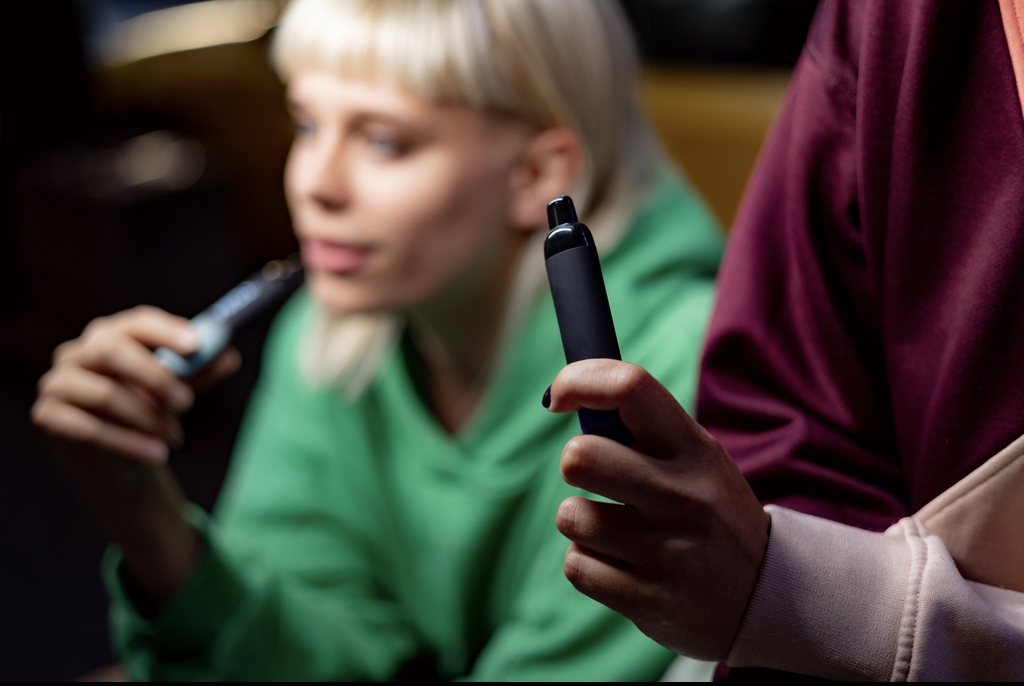In recent years, the allure of vaping has enticed millions to trade in their cigarettes for the sleek, fruity-smelling e-cigarettes that have taken over the market. These devices are often marketed as a “healthier” alternative to smoking, but emerging evidence suggests that vaping may be just as harmful—if not more so—than traditional cigarettes. Recent simulations have begun to uncover the disturbing effects that vaping has on our bodies, shedding light on a practice that many had believed to be relatively safe.
The Rise of Vaping: A Trend with Hidden Dangers

Vaping has become a global phenomenon, particularly among younger populations. With its eye-catching designs and a variety of enticing flavors, e-cigarettes have quickly gained popularity. The technology behind these devices is relatively simple, consisting of a mouthpiece, a heating element, a battery, and a cartridge filled with e-liquid. When the liquid is heated, it vaporizes, allowing the user to inhale it—much like traditional cigarette smoke, but with a sweeter taste.
However, it’s this very convenience and appeal that make vaping particularly dangerous. While vaping is often seen as a less harmful alternative to smoking, recent studies and simulations have begun to reveal the dark side of these devices. The ingredients in e-liquids, while seemingly innocuous, can have serious consequences when inhaled into the lungs.
The Misleading Appeal of Flavored E-Cigarettes
One of the biggest draws of vaping, especially for teenagers and young adults, is the wide variety of flavors available. From cotton candy to mango, these flavors are designed to make vaping a more enjoyable experience. But this is where the real problem lies.
According to a study conducted by Truth Initiative in 2023, an alarming 4.6% of middle school students and 10% of high school students—amounting to approximately 2.13 million students—reported using e-cigarettes in the past 30 days. Among these young users, 89.4% preferred flavored e-cigarettes such as Elf Bars, Lost Mary, and GeekVape. This preference for flavored vapes highlights a troubling trend: vaping has become a widespread social activity among teenagers, who may not fully understand the risks involved.
The Harmful Ingredients Lurking in E-Liquids

E-cigarettes might seem harmless, but the reality is far from it. Many of the ingredients in e-liquids can be detrimental when inhaled, and one of the most concerning is diacetyl. While diacetyl is commonly used in food products, it’s a different story when it enters the lungs.
A simulation posted by The Infographics Show on YouTube demonstrated the severe impact that diacetyl and other chemicals in e-cigarettes can have on the lungs. The simulation showed how these substances can build up mucus in the lungs and damage the alveoli, which are crucial for oxygen exchange. Over time, this damage can lead to serious respiratory issues, including a condition known as “popcorn lung,” where the small airways in the lungs become scarred and constricted.
Vaping’s Paralytic Effect on Lung Cilia
Another alarming finding from the simulation is the paralytic effect that vaping has on the lung cilia. Cilia are tiny hair-like structures that line the airways and help to keep the lungs clear of mucus, dirt, and other foreign particles. When exposed to the chemicals in e-cigarettes, these cilia can become paralyzed, meaning they can no longer perform their crucial role in protecting the lungs.
This paralysis can last for weeks, during which time the lungs are left vulnerable to infections and other illnesses. Without the cilia’s protective function, harmful substances can accumulate in the lungs, leading to conditions such as bronchitis, pneumonia, and even cancer. This stark reality is a far cry from the “healthier” image that vaping companies often promote.
The Impact of Vaping on Long-Term Health

While vaping is often marketed as a tool to help smokers quit traditional cigarettes, the potential long-term health impacts cannot be ignored. The accumulation of harmful chemicals in the lungs, combined with the paralysis of lung cilia, creates a perfect storm for respiratory diseases. Over time, the damage caused by vaping can be just as severe—if not worse—than that caused by smoking.
One of the most significant concerns is the impact of vaping on younger users, whose bodies are still developing. The Truth Initiative study found that 11.4% of middle school students and 29.9% of high school students who use e-cigarettes do so daily. This regular exposure to harmful chemicals at such a young age could have devastating effects on their long-term health, increasing their risk of developing chronic respiratory conditions and other serious illnesses.
Why It’s Time to Ditch the Vape

Given the growing body of evidence highlighting the dangers of vaping, it’s clear that this trend is not as harmless as it may seem. For those who currently vape, the best thing you can do for your health is to quit as soon as possible. While giving up vaping may be challenging, especially given its addictive nature, it’s important to remember that the risks far outweigh the benefits.
If you’re struggling to quit, there are resources available to help you. Consider seeking support from a healthcare professional or joining a support group where you can share your experiences and learn strategies for quitting. It might also be helpful to replace vaping with healthier activities, such as exercising or picking up a new hobby, to take your mind off the cravings.
Conclusion
Vaping has quickly become a popular alternative to smoking, especially among young people. However, as new research and simulations reveal the hidden dangers of e-cigarettes, it’s becoming increasingly clear that vaping is not the safe alternative it’s often portrayed to be. From the harmful chemicals lurking in e-liquids to the potential long-term health impacts, the risks associated with vaping are too significant to ignore.
If you’re a current vaper, now is the time to reconsider your habits. The sooner you quit, the better your chances of avoiding the severe health consequences that vaping can bring. And for those who have never vaped, the evidence is clear: it’s best to steer clear of this dangerous trend altogether.


